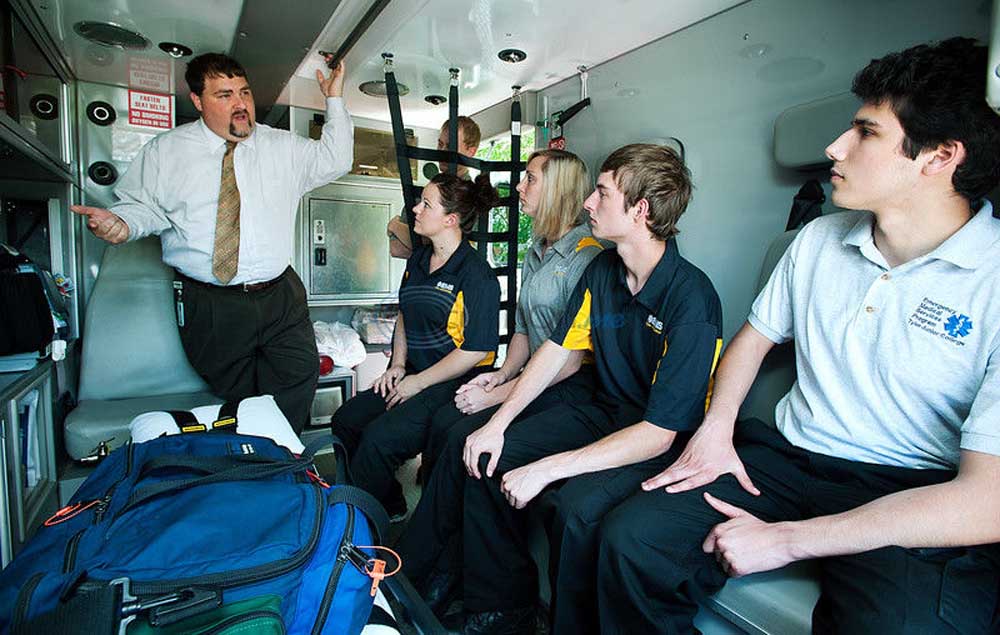TJC overhauls EMT, paramedic program
Published 9:42 pm Monday, June 15, 2015

- Instructor TC Howard, Emergency Medical Services director of clinical educational services for East Texas Medical Center, explains the operation and equipment in an ambulance to EMS students, from left, Jake Cahill, Hannah Rootes, Jennifer Russe, Eli Edwards and Noah Fanous on Wednesday, May 27, 2015, outside the Pirtle Technology Building on the Tyler Junior College campus in Tyler. The ambulance was donated by ETMC as part of a partnership between the college and the hospital to train the next generation of emergency responders. Andrew D. Brosig/Tyler Morning Telegraph
Stretchers were used to carry soldiers off the battlefields of the Civil War. But that was merely getting bodies out of the way in order for the fight to continue and was not the start of emergency medical service.
EMS did not develop until the late 1960s in the form of funeral homes responding to emergency calls and taking people either to a hospital or a funeral home.
Trending
That was found to be a conflict of interest, and emergency medical service evolved as a part of the health care industry, T.C. Howard, chairman of the EMS program at Tyler Junior College and director of clinical services for East Texas Medical Center’s EMS, said.
EMS is still a new field, although now paramedics and technicians are being accepted, not just in ambulances but also into the hospital environment and multiple areas of health care, Howard said.
TJC’s emergency medical services professional training program, in partnership with ETMC, trains EMS technicians and paramedics. The program is evolving.
Effective this fall, changes will be made in the curriculum and instruction, schedule, organization and even student uniforms, which will change to look more professional.
Currently, there are approximately 50 students training to become an emergency medical technician, which takes one semester for certification. Eighteen are studying to become paramedics, which takes two years to earn an associate degree in paramedicine.
“We have changed the format of the entire program,” Shay Steel, TJC’s program coordinator, said.
Trending
In the past, the program schedule never allowed for working individuals to sign up, because students had to attend classes from 8 a.m. to noon Mondays through Thursdays, making it virtually impossible for them to maintain a full-time job.
As the program’s new coordinator, Ms. Steel had the idea to create a schedule that allowed the working individual to attend school while working full time.
Some students who have jobs are employed by the two major hospitals in Tyler and their affiliates in other towns, Champion EMS, fire departments or city police departments.
Under TJC’s new schedule, EMS students can attend class from 8 a.m. to 4:30 or 5 p.m. two days a week and can pick which two days from offerings on Mondays through Thursdays.
That allows emergency medical technicians working on a rotation schedule to develop their own schedule for school while working full-time on their regular shift, Ms. Steel said.
She anticipates the new schedule and hours added to the EMS classes will attract more EMS students and lead to an increase in the passing rates of students on national exams. Classes are conducted in the Pirtle Technology Building.
“We completely rearranged the curriculum,” Ms. Steel said. “It’s more logical; everything builds on the previous section, where before we had the salad bar approach where you just pick and choose. Now it is step by step.”
Students study everything from the most basic anatomy and physiology to the most complicated concepts in treating rare things in the human body, Ms. Steel said.
The concept of having a paramedic on an ambulance is that the ambulance brings the emergency room to the patient, short-cutting the time in between when the patient’s problem happens and when the patient receives high-quality care and their outcome is better, Ms. Steel said.
Class discussions include new procedures and new devices. “We want students to be on the cutting edge,” Howard said. “EMS is taking things out of the hospital directly to the patient, and that’s what we are teaching (EMS students) to do.”
Students are being trained to treat the patient from the time they encounter the patient on the scene, as opposed to a patient having to wait in an emergency room, Howard said.
“We are basically taking the emergency room from the hospital to the field and instituting that care sooner. The equipment we carry and the things we do are the same thing you get in the emergency room,” he said.
ETMC has donated an ambulance for use in training EMS technicians and paramedics to treat patients in their living room.
The program also shares simulation equipment with TJC’s nursing and allied health programs in the Robert M. Rogers Nursing and Health Sciences Center. In addition, students train in clinical settings. All students are required to spend a certain amount of time in an ambulance, called “ride outs.”
They also spend time in surgery, where they learn to put breathing tubes down a patient’s throat, they spend time in a pediatric clinic learning how to work with children and they go to labor and delivery.
EMT students will spend 100 hours in clinicals in one semester. Paramedic students will complete roughly 120 hours per semester in clinicals and 16 hours a week in lectures, or 500 hours over three semesters.
“It is an intensive educational experience,” Ms. Steel said.
Ms. Steel and Howard want TJC’s EMS training program to be synonymous with professionalism and quality. They want anyone hiring an emergency services technician or paramedic to know when they see TJC on an applicant’s resume that they are getting a top-of-the-line employee.





